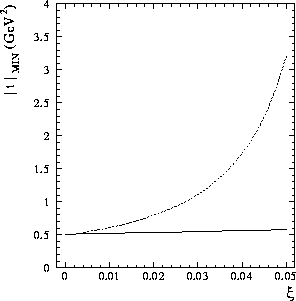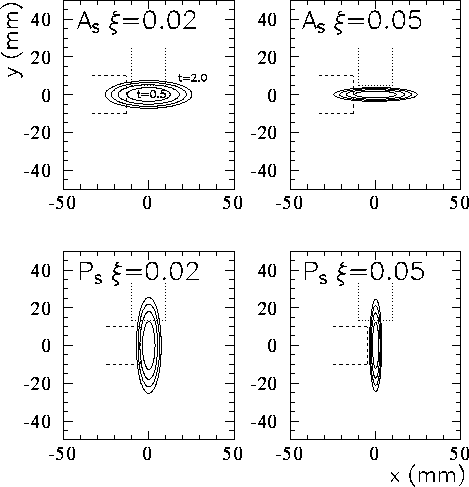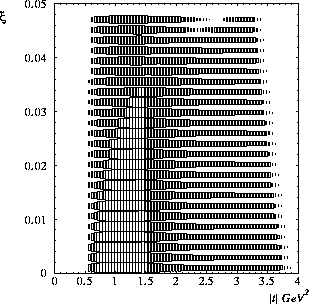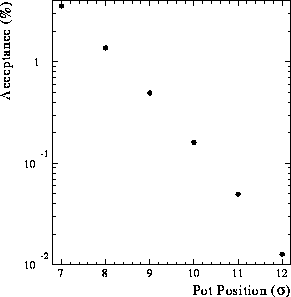Quadrupole spectrometers are fundamentally different from dipole
spectrometers, in that they require a minimum angle or |t| to
accept scattered protons rather than a minimum momentum loss.
This has the obvious advantage of fairly uniform acceptance down to ![]() ,
but the total acceptance (
,
but the total acceptance (![]() )
is typically only a few percent due to the steeply
falling |t| distribution of diffraction.
)
is typically only a few percent due to the steeply
falling |t| distribution of diffraction.
Figure 18 shows the minimum |t| value accepted by
proton and anti-proton spectrometers in the horizontal
plane as a function of ![]() for
for ![]() pot displacements. Note that
pot displacements. Note that
![]() GeV
GeV![]() for both sides at low
for both sides at low ![]() , but
while the
, but
while the ![]() side (solid curve) has little
side (solid curve) has little ![]() dependence,
dependence, ![]() increases quickly with
increases quickly with ![]() for the proton side
(dashed curve).
for the proton side
(dashed curve). The minimum |t| value is determined by the
displacement of the second pot of the spectrometer (
The minimum |t| value is determined by the
displacement of the second pot of the spectrometer (![]() or
or ![]() ),
while the maximum value of about 3.9 GeV
),
while the maximum value of about 3.9 GeV![]() is limited by the aperture at the start of the separators.
The |t| acceptance is virtually identical for pots in the vertical
plane, except that proton y pots have the superior acceptance.
is limited by the aperture at the start of the separators.
The |t| acceptance is virtually identical for pots in the vertical
plane, except that proton y pots have the superior acceptance.

Figure 18: The minimum |t| value accepted by
anti-proton (solid curve) and proton (dashed curve)
spectrometers in the horizontal
plane versus ![]() for
for ![]() pot displacements.
For pots in the vertical plane, the definition of the
curves is reversed.
pot displacements.
For pots in the vertical plane, the definition of the
curves is reversed.
This asymmetric behaviour can be explained by the different ![]() functions
discussed in Sec. 3.3, which arise from
a different arrangement of the low beta
quadrupole triplets (the proton side has DFD and
functions
discussed in Sec. 3.3, which arise from
a different arrangement of the low beta
quadrupole triplets (the proton side has DFD and ![]() side has FDF,
where F is focusing and D is defocusing).
The manner in which the asymmetry in the optics affects the
acceptance is demonstrated by
Fig. 19. This figure, similar in style to Fig. 17
for the dipole spectrometer,
shows the horizontal and vertical
displacements at the S pot location for scattered
side has FDF,
where F is focusing and D is defocusing).
The manner in which the asymmetry in the optics affects the
acceptance is demonstrated by
Fig. 19. This figure, similar in style to Fig. 17
for the dipole spectrometer,
shows the horizontal and vertical
displacements at the S pot location for scattered ![]() 's (top plots) and
p's (bottom plots).
The ellipses are contours of constant |t| ranging from 0.5 GeV
's (top plots) and
p's (bottom plots).
The ellipses are contours of constant |t| ranging from 0.5 GeV![]() for
the inner-most ellipse to 2.0 GeV
for
the inner-most ellipse to 2.0 GeV![]() for the outer-most ellipse.
Unlike the dipole case, the ellipses are centered at (x=0, y=0) independent
of
for the outer-most ellipse.
Unlike the dipole case, the ellipses are centered at (x=0, y=0) independent
of ![]() . Note the
. Note the ![]() rotation of the ellipses for p pots
relative to
rotation of the ellipses for p pots
relative to ![]() pots. By comparing the curves for
pots. By comparing the curves for ![]() (left plots) and
(left plots) and ![]() (right plots), it is easy to see that the
acceptance for horizontal (dashed brackets)
(right plots), it is easy to see that the
acceptance for horizontal (dashed brackets) ![]() pots is relatively insensitive
to changes in
pots is relatively insensitive
to changes in ![]() . For horizontal p pots, however,
the contours are very close together and the acceptance
vanishes with increasing
. For horizontal p pots, however,
the contours are very close together and the acceptance
vanishes with increasing ![]() as the ellipses become more squashed.
For vertical pots (dotted brackets) the situation is reversed, and
the acceptance is more favorable for protons. The Q pots exhibit
similar behaviour, but only the S pots are shown here since they
control the acceptance.
as the ellipses become more squashed.
For vertical pots (dotted brackets) the situation is reversed, and
the acceptance is more favorable for protons. The Q pots exhibit
similar behaviour, but only the S pots are shown here since they
control the acceptance.

Figure 19: The x and y displacements
at S pot position are shown as contours of constant |t|,
ranging from 0.5-2.0 GeV![]() (smaller |t| gives smaller
displacement) for
(smaller |t| gives smaller
displacement) for ![]() and 0.05.
The ellipses are rotated by
and 0.05.
The ellipses are rotated by ![]() as discussed in the text.
The dashed (dotted) brackets show horizontal (vertical) pots
at an
as discussed in the text.
The dashed (dotted) brackets show horizontal (vertical) pots
at an ![]() displacement.
displacement.
Placing pots in both the horizontal and vertical planes will thus give us
equal and stable acceptance for protons and anti-protons from the
quadrupole spectrometers.
Figure 20 shows
the geometric (![]() ) acceptance for horizontal and vertical pots
in bins of
) acceptance for horizontal and vertical pots
in bins of ![]() and |t| with the size of the boxes again
proportional to the geometric acceptance (the maximum acceptance
in this case is about 83%). There is no acceptance for
|t|<0.5 GeV
and |t| with the size of the boxes again
proportional to the geometric acceptance (the maximum acceptance
in this case is about 83%). There is no acceptance for
|t|<0.5 GeV![]() as discussed earlier,
but the intermediate and high |t| geometric acceptance for the quadrupole
spectrometers is seen to be superior to the dipole spectrometer.
as discussed earlier,
but the intermediate and high |t| geometric acceptance for the quadrupole
spectrometers is seen to be superior to the dipole spectrometer.

Figure 20: The geometric acceptance in bins of ![]() and |t|
for the quadrupole spectrometer with the detectors
at the nominal
and |t|
for the quadrupole spectrometer with the detectors
at the nominal ![]() displacements. The acceptance in each bin
is proportional to the size of the box, with the largest box
representing 83% acceptance.
displacements. The acceptance in each bin
is proportional to the size of the box, with the largest box
representing 83% acceptance.
The 8![]() total acceptance (
total acceptance (![]() ) is
obtained by integrating over |t| and
) is
obtained by integrating over |t| and ![]() and
ranges from 1.2 to 1.6%
for
and
ranges from 1.2 to 1.6%
for ![]() as shown in Table 3.
There is also reasonable acceptance
up to
as shown in Table 3.
There is also reasonable acceptance
up to ![]() (0.9%).
The acceptance in general does not depend strongly on the width of the active
area of the detector, as the bulk of the acceptance is in the center
of the detector. Doubling the width from 2 to 4 cm only increases
the overall acceptance by a few percent of its nominal value, since
this only improves the acceptance for very rare high |t| events,
and decreasing the width from 2 to 1.5 cm also has little effect.
(0.9%).
The acceptance in general does not depend strongly on the width of the active
area of the detector, as the bulk of the acceptance is in the center
of the detector. Doubling the width from 2 to 4 cm only increases
the overall acceptance by a few percent of its nominal value, since
this only improves the acceptance for very rare high |t| events,
and decreasing the width from 2 to 1.5 cm also has little effect.

Table 3: Integrated acceptance (in percent) for protons or anti-protons
using ![]() Roman pot locations in both the
horizontal and vertical planes vs.
Roman pot locations in both the
horizontal and vertical planes vs. ![]() and
and ![]() .
.
As mentioned earlier, the total acceptance is quite sensitive
to pot position, and we expect to place the quadrupole
spectrometer pots between
8 and 9![]() . Figure 21 shows the acceptance
for protons (or
. Figure 21 shows the acceptance
for protons (or ![]() 's) with
's) with ![]() as a function of
pot displacement in units of
as a function of
pot displacement in units of ![]() . The acceptance is
seen to decrease by about a factor of three for each additional
. The acceptance is
seen to decrease by about a factor of three for each additional
![]() unit: the nominal 8
unit: the nominal 8![]() acceptance of 1.3%
increases to 3.6% for 7
acceptance of 1.3%
increases to 3.6% for 7![]() , and decreases to 0.5% for 9
, and decreases to 0.5% for 9![]() .
.

Figure 21: Acceptance for scattered
protons (or ![]() 's) as a function of the pot position
in units of
's) as a function of the pot position
in units of ![]() .
.
Other factors going into the exact acceptance include beam crossing angles (next section), the final details of the lattice (which could affect the acceptance by roughly a factor of two in either direction), and the emittance (which would affect the acceptance if it is much smaller or larger than the expected value).